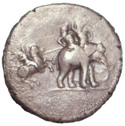Poros
 | |
| władca Pendżabu | |
| Okres | od 340 p.n.e. |
|---|---|
| Dane biograficzne | |
| Miejsce urodzenia | |
| Data i miejsce śmierci | 320 lub 315 p.n.e. |
| Przyczyna śmierci | zamordowany |

Poros (gr. Πῶρος, zm. ok. 320 r. p.n.e.) – indyjski władca. Podjął próbę powstrzymania atakującej Pendżab armii Aleksandra Wielkiego.
Brak istotnych danych o początkach panowania tego władcy. W 326 roku p.n.e. do rzeki Hydaspes stanowiącej granicę państwa Porosa, dotarła armia macedońskiego władcy Aleksandra Wielkiego. Indyjski władca zdecydował się stawić opór na rzece (bitwa nad rzeką Hydaspes). W walce wykorzystał specjalnie wyszkolone słonie bojowe. Zwierzęta te wzniecały panikę w szeregach macedońskich żołnierzy. Obie armie stały naprzeciw siebie po obu stronach rzeki do czasu aż Aleksander poprowadził część swych wojsk w górę rzeki i zaatakował wojska Porosa od tyłu. Żołnierze indyjskiego władcy stawiali opór, ale po ucieczce przerażonych słoni musieli się wycofać, a Poros przegrał bitwę.
Podczas rozmów pokojowych jego odwaga i duma miały wywrzeć wielkie wrażenie na macedońskim królu, który zgodził się pozostawić go przy władzy w zamian za uznanie macedońskiej zwierzchności. Po śmierci Aleksandra Poros został jednak zabity przez jednego z macedońskich wodzów – Eudemosa. Wiadomo, że był postawnym mężczyzną wyróżniającym się dwumetrowym wzrostem oraz szlachetnym obliczem.
Bibliografia
- Alex Axelrod, Charles Phillips: Władcy, tyrani, dyktatorzy. Leksykon. Warszawa: Politeja, 2000
- Michał Piekarski: Hydaspes 326 p.n.e. Warszawa: Bellona, 2019
Media użyte na tej stronie
Autor: User PHGCOM, Licencja: CC0
Cropped from File:Alexander victory coin Babylon silver c 322 BCE.jpg by PHGCOM
"Victory coin" of Alexander the Great, minted in Babylon c. 322 BC, following his campaigns in the Indian subcontinent. Reverse: Alexander attacking king Porus on his elephant. Silver. British Museum.
See Keyne Cheshire, Alexander the Great (Cambridge University Press, 2009), p.139: "perhaps issued as early as 324 BCE" and depicts "Alexander charges Porus, who hurls a javelin from atop his elephant"Alexander and Porus by Charles Le Brun, painted 1673.
Le Brun also spelled LEBRUN (b. Feb. 24, 1619, Paris, France--d. Feb. 12, 1690, Paris), painter and designer who became the arbiter of artistic production in France during the last half of the 17th century. Possessing both technical facility and the capacity to organize and carry out many vast projects, Le Brun personally created or supervised the production of most of the paintings, sculptures, and decorative objects commissioned by the French government for three decades during the reign of Louis XIV. Under his direction French artists created a homogeneous style that came to be accepted throughout Europe as the paragon of academic and propagandistic art. [Encyclopaedia Britannica, 1994]
Lebrun, Charles (1619-90). French painter and art theorist, the dominant artist of Louis XIV's reign. After training with Vouet he went to Rome in 1642 and worked under Poussin, becoming a convert to the latter's theories of art. He returned to Paris in 1646. From 1661 he became established in the employ of Louis XIV, in 1662 he was raised to the nobility and named Premier Paintre du roi, and in 1663 he was made director of the reorganized Academie, which he turned into a channel for imposing a codified system of orthodoxy in matters of art. His lectures came to be accepted as providing the official standards of artistic correctness and, formulated on the basis of the Classicism of Poussin, gave authority to the view that every aspect of artistic creation can be reduced to teachable rule and precept. In 1698 his small illustrated treatise Methode pour apprendre a dessiner les passions... was posthumously published; in this, again following theories of Poussin, he purported to codify the visual expression of the emotions in painting.
Despite the Classicism of his theories, Lebrun's own talents lay rather in the direction of flamboyant and grandiose decorative effects. Among the most outstanding of his works for the king were the Galerie d'Apollon at the Louvre (1663), and the famous Galerie des Glaces (1679-84) and the Great Staircase (1671-78, destroyed in 1752) at Versailles. His importance in the history of French art is twofold: his contributions to the magnificence of the Grand Manner of Louis XIV and his influence in laying the basis of academicism. Many of the leading French artists of the next generation trained in his studio. Lebrun was a fine portraitist and an extremely prolific draughtsman.

